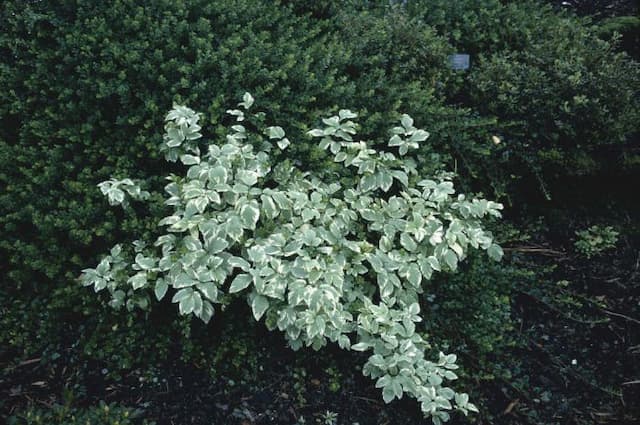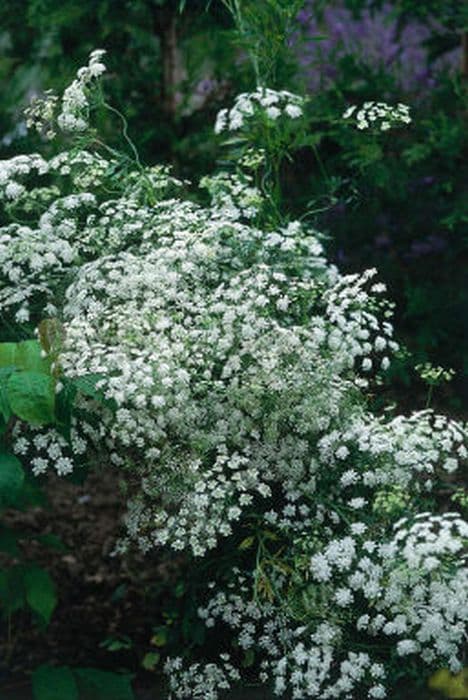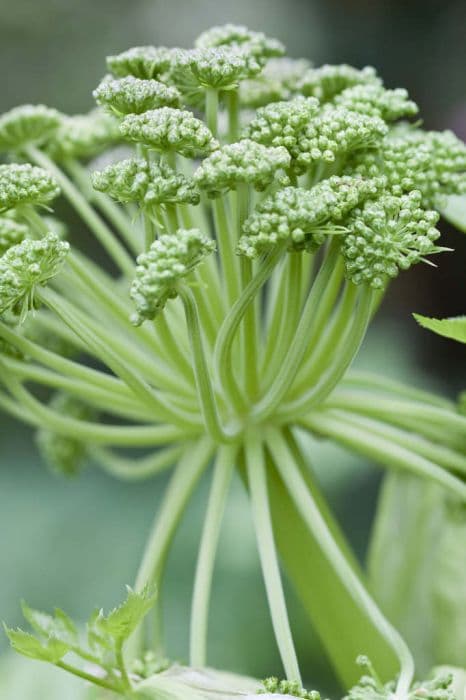Madeira Giant Black Parsley Melanoselinum decipiens

ABOUT
The plant known as the Madeira Giant Black Parsley displays a unique and dramatic appearance. Boasting large, deeply divided leaves, it resembles an oversize fern or a giant version of flat-leaf parsley. Each leaf is lush and dark green in color which contrasts starkly with the thick, purple-black stems, adding to its impressive visual impact. Throughout late winter and spring, this plant produces tall stalks topped with umbrella-like clusters of small, pale pink flowers, giving it an almost otherworldly look. These flowers attract a variety of pollinators, adding to the vibrant life around the plant. The Madeira Giant Black Parsley presents a tropical aesthetic and can add a touch of the exotic to any setting in which it is placed.
About this plant
 Names
NamesSynonyms
Madeira Giant Black Parsley
Common names
Melanoselinum decipiens
 Toxicity
ToxicityTo humans
Melanoselinum decipiens, commonly known as the Madeira Giant Black Parsley, is not widely recognized for its toxicity to humans. There is limited available information suggesting that this plant is highly poisonous. However, as with many plants, individual sensitivity can vary, and it is generally advisable to avoid ingestion of unknown plants due to the potential for allergic reactions or gastrointestinal upset. If you suspect poisoning from any plant, including the Madeira Giant Black Parsley, it is important to seek medical attention promptly. Symptoms could potentially include nausea, vomiting, abdominal pain, and diarrhea, but specific information on the toxicity of this particular plant is scarce.
To pets
Melanoselinum decipiens, known commonly as the Madeira Giant Black Parsley, does not have a well-documented profile of toxicity in pets. The plant is not commonly listed as a toxic species to pets such as dogs and cats. However, the absence of widely-known toxicity does not guarantee that a plant is safe. Any consumption of non-food plants by pets should be treated with caution, monitoring for any signs of ill effects such as vomiting, diarrhea, or unusual behavior. If you suspect your pet has ingested any part of the Madeira Giant Black Parsley, it is wise to consult with a veterinarian, especially if your pet displays any concerning symptoms.
 Characteristics
CharacteristicsLife cycle
Biennials
Foliage type
Evergreen
Color of leaves
Green
Flower color
Purple
Height
6 feet (1.83 meters)
Spread
4 feet (1.22 meters)
Plant type
Herb
Hardiness zones
9
Native area
Madeira
Benefits
 General Benefits
General Benefits- Ornamental Value: Melanoselinum decipiens, also known as the Madeira Giant Black Parsley, adds aesthetic appeal to gardens with its tall, architectural structure and lush green foliage.
- Wildlife Attraction: The plant's flowers can attract a variety of pollinators, including bees and butterflies, which are important for the environment.
- Drought Tolerance: Once established, it has good drought resistance, making it suitable for xeriscaping or gardens with low water availability.
- Shade Tolerance: It is capable of growing in partial shade, offering flexibility for placement in various garden designs.
- Soil Adaptability: Madeira Giant Black Parsley can adapt to a range of soil types, although it prefers well-draining ground.
 Medical Properties
Medical PropertiesThis plant is not used for medical purposes.
 Air-purifying Qualities
Air-purifying QualitiesThis plant is not specifically known for air purifying qualities.
 Other Uses
Other Uses- Madeiran Giant Black Parsley can be used as a source of dark purple dye for textiles. The roots contain pigments that can tint fabrics with a purple hue.
- The tall and robust stems of this plant can be employed as natural stakes in the garden to support other, more delicate plants prone to drooping.
- The unique umbrella-like structure of this plant's foliage provides a creative option for floral arrangements and bouquets.
- The leaves can be used in crafts for making impressions in clay or plaster, adding a natural motif to pottery or relief artwork.
- It can be planted as a living fence in mild climates due to its height and lush foliage, providing both privacy and ornamental value.
- Madeiran Giant Black Parsley's seeds can be used in ornamental seed art, due to their distinct size and shape.
- When dried, the plant's seed heads can be used to create rustic and decorative indoor displays or as part of autumnal wreaths.
- As a large plant, it can serve as a natural windbreak in coastal or exposed gardens, helping to protect other plants.
- The plant can be used in educational settings such as botanical gardens to illustrate the endemic flora of Madeira and island biodiversity.
- In landscape design, the architectural form of Madeiran Giant Black Parsley provides a dramatic focal point in sub-tropical themed gardens.
Interesting Facts
 Feng Shui
Feng ShuiThe Madeiran Giant Black Parsley is not used in Feng Shui practice.
 Zodiac Sign Compitability
Zodiac Sign CompitabilityThe Madeiran Giant Black Parsley is not used in astrology practice.
 Plant Symbolism
Plant Symbolism- Rarity: The Madeira Giant Black Parsley is relatively uncommon and not widely known, symbolizing uniqueness and the value of rarity in nature.
- Endurance: Native to the Atlantic island of Madeira, this plant's ability to thrive in a specific and isolated environment symbolizes endurance and adaptability.
- Mystery: With its striking appearance and uncommon status, the Madeira Giant Black Parsley can symbolize the mysterious and the intriguing elements of the natural world.
- Isolation: As it is native to an isolated island, this plant can symbolize solitude and the beauty of solitary existence.
- Strength: The robust nature of the Madeira Giant Black Parsley, capable of growing in harsh conditions, can symbolize inner strength and persistence.
 Water
WaterThe Madeiran Cranesbill requires watering when the top inch of soil feels dry to the touch. It is generally advisable to water this plant deeply once a week, providing it with around 1 to 1.5 gallons of water, depending on the size of the plant and environmental conditions. During the growing season in spring and summer, keep the soil consistently moist but not waterlogged. In winter, reduce watering to every other week or when the soil is dry, as the plant requires less moisture during this dormant period.
 Light
LightThe Madeiran Cranesbill thrives in partial shade to full sun conditions. It prefers a spot that receives several hours of sunlight but is shielded from the intense midday sun. A location that provides morning sunlight and afternoon shade is ideal to prevent leaf scorch while ensuring the plant receives adequate light for growth.
 Temperature
TemperatureThe Madeiran Cranesbill is hardy and can withstand a range of temperatures, but ideally, it should be grown in conditions between 50°F and 75°F. It can survive brief dips in temperature down to 30°F but sustained cold can damage the plant. It is not tolerant of high heat, so ensure it stays below 85°F to avoid stress or heat damage.
 Pruning
PruningThe Madeiran Cranesbill should be pruned to maintain its shape and remove any dead or damaged foliage. Prune the plant after flowering to encourage a second bloom and improve its overall appearance. This task is typically done in late summer or early fall. Regular deadheading of spent flowers can also promote further blooming.
 Cleaning
CleaningAs needed
 Soil
SoilThe Madeira Giant Black Parsley thrives in rich, well-draining soil with high organic matter content. A soil pH ranging from 6.0 to 7.5 is optimal. A mixture of loam, peat, and sharp sand can create the ideal conditions for this plant's growth.
 Repotting
RepottingMadeira Giant Black Parsley should be repotted every 2 to 3 years or when it outgrows its current pot. It's best to repot in spring just before the new growth starts.
 Humidity & Misting
Humidity & MistingMadeira Giant Black Parsley prefers moderate humidity levels. Aim to maintain the humidity around 50-60% for optimal growth of this plant.
 Suitable locations
Suitable locationsIndoor
Ensure bright, indirect light and moderate humidity for indoor Madeira Giant Black Parsley.
Outdoor
Plant in partial shade, shelter from wind for outdoor Madeira Giant Black Parsley.
Hardiness zone
9-10 USDA
 Life cycle
Life cycleMelanoselinum decipiens, commonly known as Black Parsley, begins its life cycle when seeds germinate, typically in a humid and cool environment. The seedlings develop into a basal rosette of leaves during their first growth stage, with foliage that may persist through the winter in mild climates. In the following year or after several years, the plant bolts, sending up a tall flowering stem which may reach several meters in height. The distinctive umbels of purplish or white flowers bloom, attracting pollinators and eventually setting seed. After seed setting, the monocarpic Black Parsley dies, completing its life cycle. The dispersed seeds can remain dormant until conditions are favorable for the next generation to begin the cycle anew.
 Propogation
PropogationPropogation time
Spring to early summer
The most popular method of propagation for the Madeiran Giant Black Parsley (Melanoselinum decipiens) is through seed sowing. The best time to sow seeds is in late winter to early spring, just before the last frost. Sow the seeds thinly in small pots or trays filled with a seed starting mix, barely covering them with soil as they need light to germinate. Keep the soil evenly moist but not waterlogged, and place the pots in a warm, bright location without direct sunlight. Germination can be erratic, but you can expect seedlings to emerge in 2-4 weeks. Once the seedlings are large enough to handle, transplant them into individual pots, and later, when the risk of frost has passed, they can be planted outdoors in their final position.









